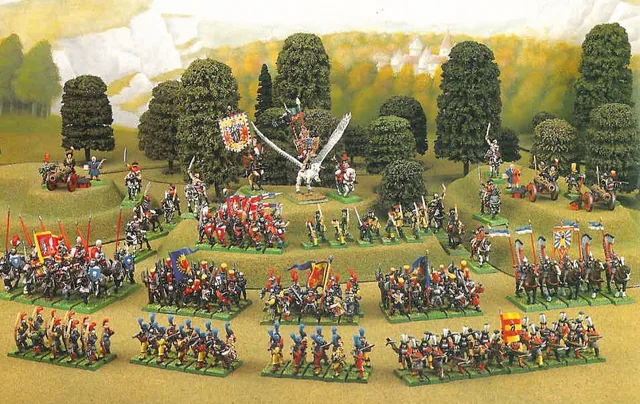I’m exciting for The Old World, don’t get me wrong, but have you seen how big these units are?
For most of Warhammer Fantasy’s existence a player could look at official images and see a pretty good representation of how units would show up on the tabletop. There were almost always too many units, arranged dramatically, if not quite realistically, but they would usually have the normal number of minis, arranged in a normal formation (a block of four ranks). Through most of the editions you would generally see basic, core infantry units in blocks of anywhere from 16 to 25 minis (usually 20), with ranged and elite infantry sometimes going as low as 10. Even chaff, like Goblins and Skaven, are rarely depicted with 30 minis. This holds true right up until 7th and 8th edition when the wheels start to come off the rails.
The primary reason for this phenomenon, the single most important thing keeping this soft cap in place, was how ranks worked in Warhammer. Units got a bonus to their combat resolution for every rank behind the first, up to a total of three, so most units were deployed in four total ranks. You only needed four models, side by side, to count as a rank. You could add more files, widening the frontage of a unit, but there was no point in adding a fifth or sixth rank, except to soak up casualties. Then in 7th edition ranks were required to have 5 models, and in 8th edition the horde rule allowed an entire extra rank to make supporting attacks if the unit was deployed 10 minis wide (that is a whole lot of attacks). This lead to “Death Star” units of 40 or more minis.
Every indication is that unit sizes in The Old World will be just as bonkers huge as they were in 8th edition. Look at the above image. That is a unit of peasant archers eight across and four deep; 32 minis. Look through the images in the most recent Dev Diary and you will see more of the same. Elite infantry shows up in blocks of 18 or 20 minis, and standard troops in bricks of anywhere from 24 to 32. On top of this, cavalry is often shown in blocks of 10 and chariots in groups of 2.
When these models were last in production they were sold in sets half this size. Orc Boys, Dwarf Warriors, Bretonnian Bowmen all came in boxes of 16 models (4×4, bear minimum for full rank bonus!). Greatswords, Ironbreakers and Sword Masters all came in boxes of 10 and Boar Boys in 5. Are we going to need to buy two boxes to field one unit, or will unit boxes now have double the minis at double the price? Moreover, these larger units take more time to paint, raising the barrier to having a fully painted army. How many players will never get an army painted, those that survive the sticker shock, that is?
The issue of unit size also distorts a change of which I am in favor, increasing base sizes. Bases are a favorite gripe for many folks online, but one I have rarely worried over myself. After Warhammer Fantasy Battle blew up I started basing everything on 25mm round bases and have never looked back. The extra arm room is really nice for ranking up units that were extremely fiddly on 20mm squares. I have a couple 6th edition armies on 25s and they look great. But if you double their unit sizes suddenly you have far less room to play. You can try it out yourself: cut out some pieces of paper and put them on a tabletop to see what I mean. 1 inch is 25.3mm, which means that a unit 8 models across and 4 deep is 200mm by 100mm, or nearly 8″x4″. That’s pretty huge!
Who knows what the final game will look like. Maybe these unit sizes won’t be a big deal, but I can’t help but feeling a sense of disquiet looking at each new picture showing very large units on the tabletop. What do you think? Let me know in the comments.
And remember, Frontline Gaming sells gaming products at a discount, every day in their webcart!



